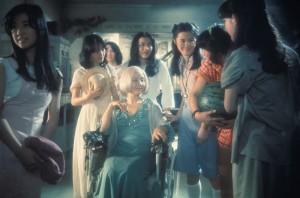Los Angeles exists as it does today because of the movies. Initially rolling hills and orange groves, it has become a major American metropolis because of its status as the filmmaking capital of the world. As a result, movies are present everywhere. In Westwood and its surrounding areas alone, there exists a large number of independent theaters that show a wide range of films, from huge blockbusters to small foreign productions.
Each week, I will highlight some of the screenings going on throughout the area. As the column title “Out of Focus” suggests, I am specifically spotlighting films that aren’t talked about often – motion pictures on the periphery.
Classic movies. Art house fare. Forgotten films from yesteryear.The selection discussed each week will be a work that many people are unaware of but that they may find much interest in.
This week’s selection is “House,” a Japanese horror gem from 1977.
“House” (1977)
Directed by Nobuhiko Ôbayashi
You’ve seen them before. Zany, absurd, off-the-wall Japanese commercials that are thoroughly incomprehensible and often have no relation to the product being sold. Throughout the early 1970s, Nobuhiko Ôbayashi was the king of these advertisements, the veritable wizard of television strangeness. Then, in 1975, his eleven-year-old daughter devised a story for a film. The result was 1977’s “House,” a movie so bizarre, so delirious and so unusual that it beats his commercials tenfold. The film will be playing Jan. 10th at the Nuart Theatre in Santa Monica.
Wildly imaginative and visually stunning, “House” is a mad haunted house romp that has drawn comparisons to everything from Scooby-Doo to the works of Dario Argento for its campy plot and ultra-stylized horror violence.
“House” follows the lives of seven Japanese schoolgirls – Melody, Gorgeous, Mac, Prof, Sweet, Fantasy and Kung Fu. During their summer vacation, the girls retreat to an old, grandiose house in the countryside, owned by one of the girls’ aunt. Almost immediately, though, strange things begin to happen to the girls. Before long, they begin to be killed one by one by an unknown spirit.
The film meshes a variety of different film genre stereotypes, with odd editing techniques and unrealistic, even cartoonish special effects, creating a disjointed, peculiar style all its own. It’s part murder mystery, part fantasy film, part black comedy and part surrealistic horror movie.
It has the stylistic excess of an early MTV music video, the aesthetic look of an old arcade game and the frenetic quality of the Japanese commercials Ôbayashi was known for.
When many people think about Japanese movies, they think of two types of films: historical epics chronicling the tales of samurai and shoguns, or quiet, contemplative melodramas. However, Nobuhiko Ôbayashi’s masterpiece “House” is as far removed as can be from the introspective cinema of the old masters, such as Ozu and Mizoguchi. It is a shining example of just how diverse the cinema of Japan is, standing as one of the strangest film offerings ever produced by the country, or for that matter, any country.

One has to wonder how such an unconventional film was ever given the go-ahead by the Toho Company, Japan’s premier movie studio. It’s hard to imagine a studio head green-lighting a film dreamt up by a preteen girl, directed by a man famed for cologne commercials and starring a cast of unprofessional actors (the seven schoolgirls were all played by models with no prior experience, and it often shows). It’s even harder to understand the sensation the film caused when it was first shown. Upon its initial release in Japan, “House” was advertised everywhere, splashed across the newspapers as it slowly invaded the public consciousness. Nearly two years before it was even filmed, it received advertising through a variety of different mediums. Comic books. Bubble gum cards. Soundtrack albums. Radio dramas. Japan was abuzz with news of such an untraditional film.
Even after it was released to mostly bad reviews, it was a huge success, especially with younger audiences. Then, almost as quickly as it appeared, it drifted away into obscurity, destined to gather dust in Japanese film archives. That all changed a few years ago when Janus Films secured the American distribution rights to it, marking the first time the film would be shown in U.S. theaters. Ever since, “House” has risen in popularity, becoming an underground cult classic across the country. Like “The Rocky Horror Picture Show” and “Eraserhead,” it has become a staple of the midnight movie circuit.
“House” is a wild ride, a completely hallucinatory experience. There are killer pianos, deadly grandfather clocks, severed heads and demon felines. It is thoroughly nonsensical and, simultaneously, one of the most stimulating horror films of its day. With its over-the-top, cartoonish violence and a pop soundtrack that sounds like it was pieced together from selections off of a 1970s A.M. radio program, “House” is one of the most interesting and bizarre movies in recent memory, a treasure once forgotten but now found.
